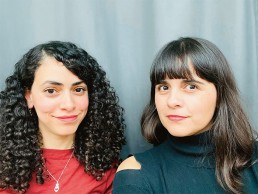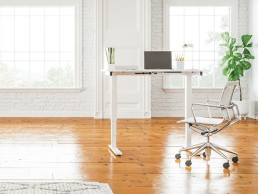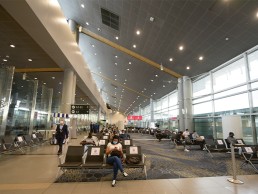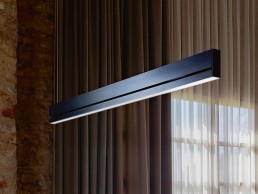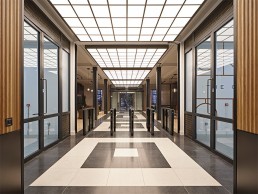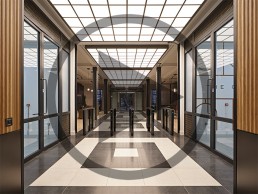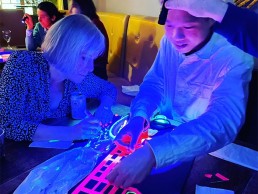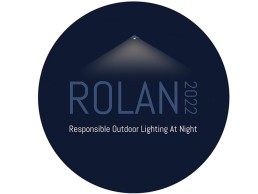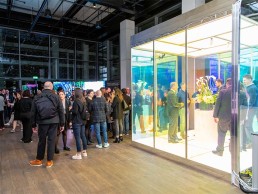Dipali Shirsat
arc talks to recent Silhouette Awards winner Dipali Shirsat about her fascinating research into multi-sensory design, and how lighting designers can create more inclusive environments for the visually impaired.
It goes without saying that light is inherently a visual medium and that by harnessing it, designers can create beautiful, inspiring, and moving scenes. But how does lighting fit into a wider, multi-sensory approach to design? What can lighting designers do in their work to create more inclusive spaces, particularly for the visually impaired?
This is the core focus for Dubai-based, Indian lighting designer Dipali Shirsat. A recent graduate from KTH in Stockholm, Shirsat’s Master’s thesis was centred on how we experience the public realm, and how through their work, designers can redefine these spaces to make them altogether more inclusive.
“The idea of doing a thesis on multisensory design came after listening to the TED Talk – Design with the Blind in Mind, by architect Chris Downey,” Shirsat told arc. “The core idea of the thesis was emphasising how ‘disability’ is a term often misused, and that people are not disabled; the spaces are. The disabled spaces are limiting so many people to get the true experience of a city, and also limiting a majority of them indoors. The research therefore talked about how an ‘image of a city’ is defined by our experience of the spaces around it, and how we as designers can help to redefine it by designing spaces that are inclusive.”
The idea of redefining and redesigning spaces has been a constant for Shirsat ever since she first discovered the world of design. She explained: “I was in the process of choosing which professional career path to go down, between medical and design. My art teacher, Bhiva Punekar was a great artist, and he gifted me a book on the life and work of the architect Laurie Baker. Just as how a small child would be fascinated when discovering something new for the first time, I remember sitting intrigued and stunned at how architecture and light can create a beautiful world.
“After reading the book, I could not stop my imagination, and would think about recreating and designing spaces that would leave oneself spellbound. Unknowingly, light had created a huge impact on my mind as an architect, and it was along this architecture journey that I started developing more interest in light and becoming more aware of it.”
Shirsat went on to study Architecture at Mumbai University in India, and she explained that during her studies, she was heavily influenced by the organic architecture and deconstructivism style of breaking the picture-perfect ideology and designing experiences that are raw and true to the space. “I never designed spaces or put forward design proposals that depicted strong geometry or right-angles,” she said.
Following her graduation, Shirsat got a job as a lighting designer at Indian practice Lighting Dimensions Studio, with a curiosity to learn more about lighting. “In the process of learning and getting to know more about the profession, I came across James Turrell’s work and was completely mesmerised by it. It felt magical and surreal,” she said.
“I only had a very brief idea of lighting until then, but when I realised and became aware of how lighting can affect not just spaces, but also how deeply it can affect human psychology and how we feel in a particular space, I knew that I had to continue practicing as a lighting designer.
“Designing comes naturally to me, and I always knew that I would be a designer, whether it be architecture, lighting, or something else. I developed myself as a holistic designer over time as I believe the roots of designing are the same, it’s just the medium of expression that is different.
“The name Dipali means ‘light’ and is derived from ‘Diwali’, which is the festival of lights in India. So, when people ask me ‘why lighting?’, I say that it is part of my identity – I was destined to be a lighting designer!”
After this realisation, like many burgeoning lighting designers Shirsat enrolled in the Architectural Lighting Design Master’s programme at KTH in Stockholm, moving to the Swedish capital in 2018. “Moving to Sweden, I was surprised to see the lack of sufficient daylighting conditions, and how people cope with it,” she said. “Coming from a place with abundant daylight, I never realised the true importance of it until I moved to Sweden.
“The different cultural and geographical experiences coupled with the research-oriented studies at KTH made me rethink my design ideologies and was imperative in developing my own research, which is based on universal design thinking.”
It was here that Shirsat delved deeper into the notion of multisensory, inclusive design, and where she began work on her thesis on the subject. In her thesis, Shirsat explained that people with visual impairments were considered as “prototypical city dwellers”, and how by understanding their needs of navigation, designers can develop an approach that looks not just for their safety, but helps them engage in outdoor spaces and enhances their nighttime experiences.
“The change in designing and building such inclusive spaces starts with change in the perception and approach of designers, for which the research outlines a very important social experiment,” Shirsat said. “The ‘blind-fold experiment’, as we called it, was so designers could get first-hand experience and understanding of the limiting factors of a space, and how these can be further used to design inclusive spaces.”
The research put forward a holistic, four-point design module for designing outdoor spaces to make them more multi-sensory. The module was put forward by Shirsat as a starting point to designing multi-sensory experiences, and how non-visual triggers of a space can be enhanced with lighting to remove the visual bias of a design.
“The four-point module gives a step-by-step guide on improving the lighting conditions in the public realm,” Shirsat explained. “The first two points of the module are focused on understanding the user needs, limitations, and doing site analysis based on the ‘human dimensions of the public space’. The third part of the module focuses on carrying social experiments that help in understanding the visual and non-visual triggers of a particular space.
“The fourth point of the module is about applying lighting techniques based on the data generated from the first three points, and particularly on enhancing the non-visual triggers through appropriate lighting. The main element to consider while doing this is the relationship between the different aspects of lighting , such as value and luminance, to primarily enhance the tactile contrast in a space, but also to look at how different lighting techniques can be applied to strengthen the non-visual sensory triggers that activate the dynamism of the space and enhance social interaction.”
Since graduating from KTH in 2020, Shirsat has relocated to Dubai, where she works as a lighting designer at neolight global. However, she continues to expand on her thesis, and is looking to continue with her research into the subject of multisensory design.
“The thesis is just a starting point to what the actual research can develop into,” she said. “I have planned on taking the research forward and doing the social experiment in different parts of the world, gaining insights into how cultural and geographical diversity affect the design thinking.
“Especially after the pandemic, when people are deprived of touch, how are the visually impaired experiencing spaces, when one of their strongest attributes of sensing spaces is taken away? The research has totally changed my design perspective and outlook on many aspects of lighting, which I never considered in designing before. It’s now always a deliberate attempt to think of the four-point module while developing any concepts for projects.”
Shirsat is also hopeful that, with the continuation of her research and the expansion of the four-point module, more designers will begin to consider how their work will impact those with visual impairments. She continued: “I believe in general the design industry has overlooked or restricted the aspect of disability and inclusiveness to only talking about the safety of people, which is of course the priority. But what about their experiences of a city, which is much more than offering safety and allowing for social interaction?
“The very basis of appreciating any work of a lighting designer is first through your visual sense, so what happens when that base is challenged? I found this topic to be interesting; to re-evaluate and rethink the design ideologies that are not sensory-based. As per statistics, more than a quarter of the world’s population experiences some form of visual impairment, and that number is expected to triple by 2050, which is an alarming issue. If we act now and implement inclusiveness in design practice, the future will be much safer and equally more enjoyable place for all.”
Shirsat’s wish to create lighting that makes a difference to the wider public is something that has been with her since she first entered into the world of lighting design. She continued: “The only thing I knew was I have to stay true to my craft and be a responsible designer.
“Inspired by James Turrell, Olafur Eliasson and Daan Roosegaarde, I hoped to bring a small but impactful change in the design field. These are big names in the industry, but what they all have in common is they represent ideas and possibilities, something I wish to represent one day as well. I hope to bring about that change with my research on lighting and disabled spaces.
“I believe that if you are passionate and have got something to say and contribute to the industry, you will eventually get recognised. I thrive on creativity and collaborating with creative minds. Whether it be social engagement through Women in Lighting, the Lighting Police project, or my own research, I’ve been connected with so many creative minds that have helped me grow and stand out.”
On Women in Lighting, Shirsat has been heavily involved in the project, running the R.A.W blog alongside Martina Frattura. But while she has been a keen contributor to the project, she said that she has always felt supported by men and women alike in the industry.
“I have been very fortunate to have equal support from the men in this industry – be it my professors from KTH, Federico Favero and Rodrigo Muro; my previous work colleague Gary Thornton, who has been very supportive of my research; to now being mentored by David Gilbey. I feel the men in this industry have really supported me and I have learnt so much from them,” she said.
“Women in Lighting has been imperative in my journey also. The R.A.W blogs have been a successful collaboration with Martina, and it’s good to know that they have generated discussions in various lighting groups. I have connected with so many talented designers from across the industry through this project, and got more opportunities to collaborate with them properly, be it working with Katia [Kolovea] on The Lighting Police, or now collaborating with David Gilbey through the Silhouette Awards mentorship programme.”
The collaboration with Gilbey comes as part of the newly created Silhouette Awards, for which Shirsat was recognised earlier this year. The awards were created to recognise young talent in the lighting industry, and to pair them with experienced mentors who can help to guide them through the beginnings of their careers.
Two months on from her recognition at the awards, Shirsat updated us on how the mentorship is going: “The first award is always special, and the Silhouette Awards is much more than just getting recognition, it has given me a mentor for life. It’s a unique concept, and especially for the young designers it’s such a great opportunity to explore their journey under the guidance of esteemed and highly experienced designers from the industry.
“Partnering up with David was one of the best things that has happened. I have known David through professional networks and being connected with him through the Lighting Police project. With the kind of industry experience and expertise he has, there is so much to learn from him not only in terms of design, but also the kind of passion he has is rare.
“David is already helping me in gaining good understanding of the business side, helping me with my research, and making sure that I get help from the right people in the industry. This is just the beginning and moving forward, I hope to collaborate with him on many exciting opportunities, be it design or doing conferences together.”
With that in mind, Shirsat already has her eyes set on the future, and is hopeful of the new opportunities that both her research, and her new mentorship, will bring. She concluded: “I always go with the flow and allow myself to be open to any interesting opportunity that might come my way.
“For now, I am focusing on this exciting journey ahead with David and the Silhouette team, and making the most out of this collaboration. I am hopeful that this journey will take me to something more interesting ahead – that’s the plan!”
The R.A.W blog can be found on the Women in Lighting website.
Maha Shalaby & Isabel Villar
Since its first episode aired in July 2020, the Sustainable Lighting Design podcast has reached more than 2,000 listeners around the world. arc chats with hosts Maha Shalaby and Isabel Villar on the success of the series.
What is the podcast about?
We started the Sustainable Lighting Design Podcast in July 2020 as part of a research-in-practice project on sustainability and health and wellbeing in the lighting design process. In each episode we invite a guest to focus on a different aspect of how light and lighting design, through daylight and electric lighting, have an impact on us and our environment, for example by analysing their impact on energy efficiency, wellbeing, light pollution and circularity. We host researchers and practitioners aiming to spread their knowledge to a broader audience, and hope that the conversations help the lighting design community to close the gap between the research and practice worlds.
How was the podcast formed?
Initially we had the idea of interviewing researchers and people working with some of the aspects mentioned above and then publish these together with the final report of our research. But shortly after we started our project, we realised that it was going to take time to get these interviews published and therefore we needed to find a more rapid and agile way to share them, to ideally challenge the way we work now, and not in a couple of years. That, together with the start of pandemic, made us think that having a podcast would be a good idea.
Why did you decide to produce a podcast?
We thought that there were not so many podcasts on sustainability in lighting design, and that during the pandemic it would be the perfect format to listen to while working from home, without the need to pay visual attention. We also saw that digital presentations often take a long time for guests to prepare, and follow a very strict flow, while in the podcast one could interact more with the guest and be more spontaneous. All guests have been very positive about their episodes, and we think that part of the success is of course, their high competence in each subject, but also that they were more relaxed and spontaneous along the session.
Can you tell us more about the research-in-practice project?
We got the idea after working on a project that focused on different issues related to sustainability and wellbeing. We saw the lack of methods and processes that combine the work that a sustainability specialist and a lighting designer do across the design process. There was a lot of discussions about sustainability but very little experience on how, in practice, we should work together and how each other’s decision along the design process impacted the end result. After that project was finalised we were hungry for more, especially for finding methods to better integrate our services, and we applied for funding from Bertil & Britt Svenssons Stiftelse in Sweden to further look into this, and we were happy to have been granted the funding. Research-in-practice is rare in our field, but so relevant, especially on two levels, first developing methods and processes to close the big gap between research and practice, and second implementing, testing and evaluating these methods in real projects.
What are your main ambitions for this series?
Our ambition is to both give a novel platform for researchers to talk about their findings and to learn what practitioners can do to create better lighting for people with the least environmental impact, but also to inspire and spread the knowledge through the lighting design community and outside it. We hope to inspire people and to give them good arguments to tackle these questions in the design process and strengthen the importance of the work we do, lifting up the importance of good lighting and how we can contribute to a more sustainable and better future.
What has the response been like?
We are over the moon with the podcast’s exposure and the feedback. To be honest we had no expectations, we did this because we believed in it, and we believed in the message that our guests wanted to share. And so far, with only seven episodes, we have more than 2,000 plays, with people listening from all over the world, USA, Sweden, Germany UK, India, Mexico, Brazil, etc.
What’s next?
After the success of the podcast, which was one part in our research project (SLD), we are now continuing to work with the other parts of the project, as we aim to publish more case studies, in addition to some development studies that we have been working on in the past year. At the moment we don’t have any new episodes planned, but we might interview new guests in a couple of months. We also have the idea of opening the podcast to others who might have a subject of interest that touches on the same themes that we address and would like to interview someone. We are open to suggestions too, and if anyone is willing to collaborate with the podcast they are more than welcome to get in touch with us.
Designers Mind: Wellbeing becoming work's partner
Continuing the discussion on employee wellbeing, Designers Mind Founder Kaye Preston explores the relationship between work and health, and how companies can provide more support to their staff.
The mental health and wellbeing of employees has never been more important. As we navigate what comes next we have a real opportunity to explore how we can optimise our physical and mental health so we can improve how we’re working.
Understanding the relationship between our health and work is paramount, as is creating a culture within organisations where employees feel their mental health and wellbeing are supported.
Wellbeing and our work
We all know our health is important, however too often it gets slotted in around a long workday, family commitments, our partners, even life admin.
Work is important, no question about it. It not only provides us with financial security but can also create purpose, connection, collaboration, creativity and confidence. Unfortunately, we often prioritise work over other areas of our lives and many times way above our wellbeing. Who hasn’t grabbed something unhealthy to eat to save time and meet a deadline, or answered emails late into the night forgoing both down time and good quality sleep? These behaviours become the norm, sacrificing our physical and mental health in the long run.
But what if I told you that improving your health can improve your work? Let’s sit with that thought for a moment.
Be honest, would this be a mindset shift or, as I imagine for many, you know this is true but still don’t make your wellbeing a top priority?
Prioritising our health can lead to improved performance, productivity, more energy, better focus, resilience and impacts our overall happiness. We could have more creativity for our projects, be better able to make crucial decisions and have more confidence in ourselves and our abilities.
I recently came across this quote that really made me think about the concept of our health and work supporting one another: “Rest is not work’s opposite, rest is work’s partner” – Alex Pang, Author and former Tech Consultant.
Could we go one step further with this and say “Wellbeing is work’s partner”?
What about organisations’ role?
I often talk about prioritising our wellbeing as a two-way street. Employees need to take responsibility for their own health and be accountable for their actions. Only they can create healthy habits and make lifestyle changes to support their own health. However, organisations need to create a culture where employee wellbeing is built into its core. The two work together.
For organisations, maintaining employee wellbeing while understanding the link between mental and physical health is key to promoting productivity. People work better when they aren’t feeling stressed, overworked, and underappreciated.
Educating your employees about healthy food and lifestyle choices, stress reduction, exercise, and ways to increase their energy will not only improve their health and overall happiness but will also allow employees to understand the true benefits that prioritising their health can have on their work and lives in general.
Creating a work culture where wellbeing is at its core with proactive and preventative measures rather than reactive solutions when problems arise has also been shown to reduce levels of absenteeism and presenteeism, increase employee morale, enhance workplace culture, attract more talented employees, reduce turnover and improve the overall employee experience.
Research from the Mental Health Foundation and The London School of Economics and Political Science (LSE) suggests that employee mental health issues alone cost the UK economy £118bn a year with almost three-quarters of the cost due to lost productivity.
A UK Survey Report by the PAM Group shows that 40% of employees see help to sustain a good work-life balance as very important for helping them to stay healthy. This form of preventative support is twice as popular as more curative solutions, with two-thirds of employees saying the wellbeing support makes them less likely to want to work elsewhere. More supported employees were also more productive and less likely to take sick leave.
Two-fifths of people also said that working for their employer has undermined their health or caused them to become sick. Meaning employers have to think about how working practices are negatively affecting their employees’ health.
Employers should create a culture of health that prioritises and values the mental health and wellbeing of its employees, where it’s integrated into operations and goals, is supported and promoted through programmes, policies, and benefits, and includes engagement from all levels.
There are steps that any employer can take to help address wellbeing in the workplace and to help ensure that people feel supported. These could include the following:
• Develop Mental Health First Aid trained ambassadors and ensure HR staff (or a nominated person) have at least some basic training to understand mental health issues.
• Offer a health benefits plan to all eligible employees that includes both physical and mental health services.
• Use the support available through employee assistance programmes (EAP).
• Addressing work/life balance issues such as out of hour emails, flexible working schedules, overtime and parental leave.
• Identify individual employees’ needs and build a supportive culture around diversity and inclusion.
Creating a culture with mental health at its core can improve employee wellbeing and morale while decreasing health-related costs. Employers can educate and support employees to make healthier lifestyle choices to improve their physical and mental wellbeing. They can also educate employees on the benefits of making time for physical health and how this can support their mental health. In return, organisations will see an increase in engagement and productivity, and a decrease in employee stress and absenteeism.
Isn’t it time we created work cultures that prioritised our mental health and wellbeing and learnt how this could support our work?
GreenLight Alliance: An Inside Look
In this issue, the GLA asked Marc Salvany, Head of Global Professional Services at Signify, to summarise the company’s policies in the direction of a Circular Economy.
To transition to a circular economy, the lighting industry needs fresh thinking on design, materials and business models.
As lighting professionals, we have an inherent appreciation of the value of light. The light that surrounds us influences the beauty and liveability of our homes, the productivity of our workplaces, the yield of our crops, and even our ability to transmit data or eradicate disease. As we demand more of our lights, so our industry grows. In 2030, there will be 35% more light points in the world than there were in 2006.
With this growth comes a duty of care. As the lighting industry has transformed, Signify has adapted our products, our processes, and our business models to the reality of the changing world around us. With the great shift to LED, we have slashed electricity consumption and its associated emissions. And through the accelerating uptake of connected systems and services, we help customers manage their use of energy resources that come with both a financial and an environmental price tag.
But all of these light points come with another associated cost: their reliance on resources and the generation of material waste. In 2021, humanity was using 1.7 times the resources our planet can sustain. Unless things change, we will require three earths to supply our needs by 2050.
At Signify, we aim to address this point through a strategic commitment to the growth of lighting for circularity – or lighting that works within the principles of the circular economy. A circular economy aims to decouple value creation from the use of resources by using those resources more effectively. Lighting for circularity changes the way we consume light to focus on the true end product – the light itself. Products are designed to be serviced, upgraded, reused, and refurbished so that the previous materials, energy, and labour inputs will last. For customers, the benefits are readily apparent: there is no need to invest in equipment, take care of management and maintenance, or commit to long term innovation paths. In many cases, we are able to offer products, systems and services that save energy, too.
Signify defines products and services as circular when they are designed to preserve value and avoid waste. This includes the following categories:
1. Serviceable luminaires (incl. 3D-printing), which are upgradable, serviceable, connectable, energy efficient, reusable and recyclable.
2. Circular components, which are exchangeable and recyclable parts, such as drivers, controls, and LED boards.
3. Intelligent systems, which monitor serviceable luminaires and enable preventive maintenance.
4. Circular services, which aims to prolong lifetime and provide customers with end-of-contract options.
In 2019, those segments comprised 16% of our global business. In 2025, we aim to double it to 32%.
How do we make our products, systems and services work for the circular economy, and how can others do the same? Harvard Business Review identified three strategies businesses can use to create a circular business model: retaining product ownership, product life extension, and design for recycling. The best combination of these strategies is dependent on considerations like the complexity involved in recovering materials, and the ease of recovering the product from customers. All three of these strategies are very much at play in Signify, with different weightings across our businesses, sectors and products.
Retaining Product Ownership
Through shifting from product to service-based goods, products can live multiples lives. In our Light as a Service (LaaS) offering, Signify makes our products available through service contracts with a typical five to ten year term. This flips our commercial offering from the nuts and bolts of the products, to the end solution. We can provide a competitive offer to customers with a zero or low upfront capital investment, take on the maintenance of the customers’ lighting, manage their lighting operations, and at the same time, ensure we continue to extract value from the products – or their components – at the end of the contract or at the end of the product’s life. In this way, we give products a useful life when customers’ lighting needs change. And by ensuring we offer our customers an integral service including both products and services through their entire life cycle and recovering them at the end, we remove uncertainty about the future of their components.
This model is particularly appealing in industries that make intensive use of light, like manufacturing, warehouses, retail or entertainment spaces. In a recent project at ArcelorMittal’s factory in Sagunto, Spain, workers had struggled with poor-quality, yellow lights that needed frequent maintenance. By switching to LED on a LaaS model, ArcelorMittal has been able to bring down energy consumption while guaranteeing a fixed lux output for the duration of the contract and ensuring that maintenance is continually carried out.
The private sector has been faster to shift to a service model, as procurement is often set up with more flexibility. However, a LaaS model is also ideal for outdoor street and road lighting, where fast maintenance and easy availability of spare parts is essential for public safety.
The growth of this service-based model gives businesses like ours extra incentive to maximise the durability and lifespan of our products, keep them well maintained, offer operations managed services, and create a cost-effective and streamlined pathway at the end of their useful life.
Product Life Extension
To contribute to a circular economy, Signify aims to create products with a long life. LEDs are a great example of a vast improvement in longevity through a technological change. In our fast-moving field, we must ensure that all of our products are durable and serviceable, but also future-proof, offering potential to be upgraded and system connected as technology moves on.
When considering lifespan, we need to also consider serviceability, and we tackle that in part through modularity in product design. By standardising and simplifying, we allow for the easy replacement of components to give products a longer functional life.
Signify’s Luma gen2 road lighting is an example of a product that is intrinsically designed for serviceability and to make use of natural resources in a much more effective and regenerative way. Every element of this multi-purpose road and urban outdoor light is designed to be easily installed, maintained and recycled to extend its useful life. First, it is made of durable materials that are easily recycled. Under the hood, all electrical components are contained within a plug and play GearFlex module to optimise and simplify maintenance and repair. Technicians can easily remove the entire module and take it to the ground for adjustments in a safe workshop environment. Maintenance instructions come built in via a Service tag QR code on every product, further enhancing the product’s serviceability. And to equip it for the future, the Luma gen2 is System ready, meaning that customers who are not quite ready to switch to smart city controls and sensors can do so at a later stage via integrated universal connectors, without wasteful and expensive replacement of equipment.
Design For Recycling
Our third strategy focuses on products and manufacturing processes that optimise recoverability of materials. In a global company operating across many product families and geographical areas, this process is complex. We therefore work with dedicated recycling partners that share our vision and goals. For example, within the EU, we participate in collective schemes for lamps and luminaires through Collection and Recycling Service Organisations (CRSOs). These CRSOs ensure sustainable financing and guarantee effective and environmentally-sound collection and recycling. In collaboration with the EU lighting industry, we’ve established a dedicated infrastructure for the collection and recycling of lamps. At the end of their life, lamps are either crushed or cut to extract components like mercury, fluorescent powder, metals and glass. The processed materials can return to the lighting industry or can be repurposed for other uses – for example, glass from processed lamps can be used for glazing, industrial or cleaning use. Through this process, we are able to re-use more than 80% of the waste collected from lamps.
A second component of design for recycling is creating products, processes and techniques that facilitate use of recycled and recyclable materials. Through our use of 3D printing as a manufacturing technique, we can locally create product components to our customers’ precise specifications. These products can be accurately designed to fit existing fittings, minimising further material replacement. They are lighter to ship, make use of fewer components, and eliminate the need for glue. At the end of their life, the polycarbonate can be shredded and made into a new design.
3D printing can be used in the smallest to the largest scale projects. At Colombia’s El Dorado airport, 3D printing allowed us to customise to the specifications of the existing lights for seamless installation, covering close to 9,000 light points within Terminals 1 and 2. This meant we could upgrade the lighting experience for airport workers and visitors while minimising disruptive and resource-heavy installation in a busy 24/7 transit hub.
3D printing also lends itself to recycled materials; for example, the Philips LED table lamp made from 24 recycled CDs, or our MS Series Projector with at least 65% recycled polycarbonate, recovered from illuminated advertising, protective hoods from machines, carports or swimming pool covers.
A transition to a circular economy will be instrumental in managing our scarce natural resources as the world’s population grows. When the lighting industry transitioned to LEDs, we showed that a shift in technology could yield a lighting solution that was not just lower in energy consumption, but superior in every way. By shifting our mindset in the way we design, consume and re-use our lights, we can address this second fundamental issue, for brighter lives and a better world.
David Morgan Review: K-scape Rail
Combining light and sound, the new Rail system from K-scape merges a miniature sound system within a linear light fixture. David Morgan takes a closer look at Rail to see how effective the pairing is.
One of the common traps in new product development is to try combining a number of different functions together in one product in the belief that the combination will achieve more than the sum of the parts. The danger is that, far from achieving synergy, the combined product does not perform any of the functions as well as the individual ones.
K-array, the Italian manufacturer of professional audio equipment, seems to have avoided this problem with its new Rail system, which combines lighting with a high-quality sound system.
K-array, based near Florence was originally founded in Mugello, Tuscany in 1990 by Alessandro Tatini, his father Carlo, and Massimo Ferrati as an audio and lighting service company that offered design solutions for theatres, cinemas, town squares, and events. The problems involved in handling and transporting heavy PA equipment for live events lead to the idea of creating slim and ultra-compact loudspeakers capable of reproducing high quality sound without the weight of traditional products. Since then, K-array has developed a variety of innovative miniaturised audio products including the remarkable Anakonda flexible linear loudspeaker system with modules that can be linked together to produce a 64-metre-long loudspeaker with a profile of only 50x30mm.
It is understood that K-array manufactures its components in Italy and has local suppliers in Tuscany, which is very unusual for the audio industry. K-array products are designed so that at least 80% of materials used can be recycled at the end of life.
One of the latest product developments from K-array is the Rail system, combining a miniature sound system with a linear lighting system. To give Rail a good chance of commercial success, a new division, K-scape, was created with the mission of putting people at the heart of design by merging technologies such as light and sound, which it says will lead to “a more immersive human centric experience to improve its connection with buildings and interiors” for everyday use.
According to Tom Riby, Global Sales and Marketing Manager of K-scape, the initial idea for the Rail system was born while K-array was developing a rigid version of its Anakonda loudspeaker that could connect up to 46 lines of audio. Alessandro Tatini, K-array’s Co-Founder, CEO, and President of Research and Development, had a moment of revelation that Riby summed up in a single question: “We were invading the space of light, so why not explore merging the two worlds together?” And so it was, with audio specialist K-array taking its first steps into the world of lighting.
The Rail system is modular and consists of two extruded 1.2-metre aluminium sections. Overall dimensions are only 35x92mm. The upper extrusion houses the uplight and three downward pointing 1x5-inch full-range cone loudspeakers along with connection and suspension components. The lower extrusion is fixed centrally, leaving a linear gap on either side for the sound to escape. This lower extrusion can house a linear downlight, an array of lensed downlight modules or a low voltage track system into which adjustable spotlights can be attached.
The light engines were developed in conjunction with Nichia and consist of very tight pitch mid power LEDs. With 270 LEDs per metre, an almost dot-free lit effect is produced. A combination of satin silver side reflectors and a number of optical film inserts provide medium beam, diffuse wide or asymmetric distributions. A combination of linear downlight and an array of lensed downlight modules is also an option.
At the moment, only 3000K 90 CRI LEDs are offered. The downward light engine provides up to 3,680 lumens with a power consumption of 33W for the 1.2-metre-long luminaire. The uplight is available with either 3000K or RGB light engines.
The spotlights are also only available with 3000K 90 CRI LEDs and provide up to 501 lumens. A 15° spot and a 25° medium beam version are the only options at the moment. All the lighting elements, including the spotlights, are individually controllable with DALI.
The Rail system is designed to be surface mounted to the ceiling or wall, suspended on airplane wire, semi-recessed or fully recessed into the ceiling.
T and L connectors are available in three lengths to create grid layouts of the system. Finishes for the metal work are standard satin white and black or custom RAL colour powder coat.
Alessandro Tatini and the R&D team at K-array worked on the design and development of the Rail system from 2018 and it was first launched in 2020.
The technology required to produce the very small loudspeakers is quite new and has allowed the overall size of the Rail system to be reduced to such a small size.
The target markets for the Rail system are understood to include offices, retail outlets and museums where the combination of light with sound will be most useful.
According to K-array, the Rail system will reduce product costs by up to 25%, up to 52% on installation costs and also reduce power consumption by up to 35% compared to using separate lighting and sound systems.
The Rail system is a nicely designed and manufactured system, though I did not have the opportunity to fully test the quality of the sound output. It will be interesting to see how easily K-scape is able to penetrate its target markets in competition with the existing multitude of available luminaires. For some projects having a combined sound and light product would be the ideal solution, but would the lighting designer also then be responsible for the audio design? I would imagine that each of the target applications will require a wider range of light source options for power, colour temperature and distribution to meet the likely project requirements. Custom luminaire lengths will also be needed to fill the range of building sizes along with glare control accessories and a wider range of dimming protocols. The Rail system incorporates quite a wide range of options, but it may need to expand on these to be specified on many projects.
Do We Need a Lighting Detox for Sustainable Cities in the 21st Century?
In this article, Dr. Karolina M.Zielinska-Dabkowska looks at relearning our connection to light and dark in context of sustainability, climate change and urban lighting.
In the context of the current climate change emergency caused by greenhouse gases emitted by human activities [1] and recent natural disasters such as hurricanes, typhoons, floods, droughts, or wildfires - sustainability defined as “the quality of causing little or no damage to the environment …” [2] should be an important aspect to be addressed by sustainable cities.
Since the establishment of the 17th Sustainable Development Goals (SDGs) [3], which includes 169 associated targets by the United Nations General Assembly in 2015, various perspectives on sustainable cities have been developed and adopted in order to achieve a better and more sustainable future for all.
However, after review, these goals appear to be limited, as they haven’t taken into account the growing body of results from lighting-related research in diverse fields such as: environmental sciences, biology, medicine, and astronomy on the impact of light pollution from outdoor illumination, especially the effects caused by new LED light sources on humans, flora, and fauna.
When the 2014 Nobel Prize for Physics was awarded for the “invention of efficient blue light emitting diodes [LEDs], which enabled bright, white, energy saving light sources” [4], the general public gained the impression that this new lighting technology would contribute to a more sustainable future for cities. As municipalities around the globe quickly convert their current functional and decorative external lighting to LED in an attempt to conserve energy and save money, other key factors are overlooked.
Although, the World Economic and Social Survey 2013 addresses energy efficiency as an environmental management pillar for sustainable cites [5], nevertheless, Our Common Future, also known as the Brundtland Report, published in 1987, defined sustainability as “meeting the needs of the present without compromising the ability of future generations to meet their own needs.” [6] This means going beyond energy savings by addressing additional elements. Also, the Rio Declaration on Environment and Development from 1992, which was seen as a guide for future sustainable development of countries and cities in principle 4, states that “In order to achieve sustainable development, environmental protection shall constitute an integral part of the development process and cannot be considered in isolation from it.” [7]
Until recently, not many people related outdoor illumination as an indirect contributor to environmental degradation and climate change, but recent studies and environmental reports link them together. For example, burning fossil fuels, which is a main contributor to global warming, has an impact on Earth’s increased temperature, and the use of fossil fuels has been used to produce electricity for outdoor illumination (up to 20% of the world’s electricity production is consumed by electrical light sources) [8]. Urban illumination (compared to rural areas with no outdoor lighting) directly impacts the climate change in cities, with spring seasons commencing earlier as the photoperiod of illuminated trees and plants is extended and their leaves bud prematurely [9]. Also, they do not lose their leaves in time for winter. This causes them to get weaker and less healthy, so they become an easy target for climate change flooding and pests. The health of trees and plants is important because they play a critical role in cities, counteracting air pollution by converting carbon dioxide into breathable air [10], they also reduce noise, lower the urban heat islands in cities, and they create important ecosystems for various organisms such as birds, insects, and mammals such as bats. The nighttime outdoor illumination of streets, buildings and urban parks also attracts insects and hastens their decline [11]. Many of these insects are crucial for the pollinating process, and without this process humans and ecosystems would not survive as 80% of food production requires pollination by other living organisms [12]. Exposure during the nighttime to blue-rich white light has numerous adverse effects on the environment, leading to problems with reproduction, the avoidance of suitable habitats, changes in seasonal migration routes and a reduction in numbers or even the extinction of certain species. Various animals like birds are attracted towards artificial lighting during migration periods, resulting in collisions with buildings and structures that can cause injury or death. Recent data indicates that around 600 species of breeding birds have been lost in European Union countries between 1980 and the present day [13]. Fish like young salmon migrate through streams, rivers, and estuaries to the ocean. These fish migrate at night cued by illumination levels, and this timing is designed to reduce predation. When attracted to illuminated urban bridges, fish become an easy target to predators such as birds and other animals, and as a consequence, their chances of survival are greatly reduced [14-15]. Nocturnal animals such as urban bats can also be negatively impacted by exterior illumination as this causes a delay or prevents the emergence from their roosts, affecting the feeding behaviour, and changing commuting and foraging routes [16]. Bats are important nighttime natural predators (insect hunters), as they make it possible to limit the use of toxic insecticides in agriculture and forests, and their presence indicates a strong, healthy, and stable natural ecosystem [17]. Also, improperly designed outdoor illumination of human settlements such as seaside condominiums, houses and hotels along beaches discourages female sea turtles from nesting, and it attracts young sea turtle hatchlings away from the sea, which decreases their chance of survival [18]. All of this can directly contribute to biodiversity loss, which is crucial for human existence and wellbeing [19-20]. The Living Planet Report, published in 2020 by The World Wildlife Fund revealed that in the last half century, vertebrate species have declined by an average of 70% [21]. It is also believed that new LED technology with high emissions of blue wavelengths of light might be the potential origin of certain chronic diseases in human beings, including cancer [22]. Today, 83% of the human population lives under light polluted skies [23], and the blue component of outdoor lighting increases light pollution much more than older lighting technology (the S/P ratio of 4000K LEDs shows they increase light pollution by 170%), completely prohibiting urban astronomy [24].
Urban lighting in sustainable cities
I have identified eight key aspects of urban lighting in sustainable cities, based on my research: Social; Safety, Security and Wayfinding; Cultural and Heritage; Environmental; Regulatory and Legal; Nighttime Economy; Public Health and Wellbeing; and Technological (Figure 2). Many of these aspects have not been taken into consideration by the UN Agenda 2030 [25]. Therefore, it is proposed that the goal SDG 11 Sustainable Cities and Communities: Make cities and human settlements inclusive, safe, resilient and sustainable [26] is updated to address these key aspects, including the mitigation proposals for the numerous adverse impacts caused by artificial lighting at night (ALAN) on public health, wellbeing, and the environment.
Social
Urban lighting should support the active use of public spaces in cities by residents and visitors during the evenings and early nights, by improving its liveability and social relationships within the urban community, regardless of gender, age, race or economic status.
Safety, Security and Wayfinding
Urban lighting should provide safety and visual reassurance in cities for elderly residents and visitors, supporting their orientation and wayfinding by guiding them around outdoor environments and public spaces with the help of appropriate lighting.
Cultural and Heritage
Decorative urban lighting should facilitate appreciation for the cultural value of the built heritage via the sensitive illumination of buildings façades, monument, structures, and artefacts to give them identities after dark.
Environmental
Urban lighting should respect not only human needs but also the natural environment including flora and fauna by reducing light pollution, and questioning what kind of urban illumination is needed, as well as where it is needed and when. It is also important to preserve humanity’s right to have visibility of the dark night sky and celestial bodies as an ancestral global common, and to also enable continual professional and amateur nighttime observations.
Regulatory and Legal
Urban lighting should be properly regulated in the form of soft and hard laws, and it should also be monitored in order to counteract artificial light pollution and its negative impact.
Nighttime Economy
Urban lighting should support nocturnal activities including tourism, retail and hospitality.
Public Health and Wellbeing
Properly designed urban lighting should take into consideration public health and wellbeing by avoiding over illumination, light trespass into the windows, balconies and gardens of residential properties, and glare, all of which can desynchronise circadian rhythms, resulting in insomnia and hormonal imbalance.
Technological
Urban lighting should save energy by using energy efficient light sources, along with luminaires that integrate proper optical design, have an appropriate light spectrum, and employ smart lighting control systems. Also, it should include aspects such as a circular economy, and the re-use and recycling of lighting equipment. Moreover, urban lighting should apply other forms of natural and inexhaustible energy such as solar energy to power the outdoor illumination of our cities.
Lighting Detox required
Currently, there seem to be an uncoordinated explosion of vividly coloured and bright outdoor illumination on building façades, in parks, and in the streetscape of many cities around the world. Many urban planners and architects appear to have discovered the new design possibilities of this new medium, overlooking the importance of thinking holistically about environmental aspects. And some lighting professionals may be unaware of the negative impact their urban illumination can cause, if not properly designed, which necessitates a serious rethink of their design approach. Unfortunately, the new knowledge of the impact of artificial lighting on humans, flora, and fauna is rarely available to them, the reason being that researchers work in isolation and do not share the findings of their scientific work with those who design cities and the lighting. However, some luminaire manufacturers recognise the importance of collaborating with researchers and lighting professionals and the need to develop new tools, as well as lighting solutions to support the safety and wellbeing of humans, flora, and fauna. Yet this process to develop appropriate solutions is not immediate. And although responsible lighting advocates are informed and knowledgeable about the various challenges, they are rarely invited to be part of the design process. Although city representatives are aware that they need to make choices that are beneficial in a long run, not only for people, but also for nature and animals, the process to coordinate all the stakeholders involved can often be overwhelming and complex.
With the recent climate change emergency and environmental degradation, it is now urgent to apply different than traditional, people-centred development approaches. To protect the future of humanity, planet Earth, and to transform our world into a healthier environment, a new paradigm shift in the form of Lighting Detox (Detoxing from too much applied light in our urban and natural environments) is urgently required.
In December 2021, the UN Human Rights Council recognised for the first time, that having a clean, healthy and sustainable environment is a human right [28]. So, other targets could possibly be included into the Sustainable Development Goals, such as protecting access to dark skies and reducing light pollution in order to preserve this common ancestral heritage shared by humanity, as well as helping safeguard the health and wellbeing of humans, flora, and fauna by the application of responsible outdoor lighting at night (ROLAN) or no exterior lighting in Urban Natural Areas, such as parks and open spaces in any city, which are not only essential for humans, but for many other species too.
References
1. European Commission, Caused of climate change. Available online: https://bit.ly/38UCr8T (accessed on 29 December 2021).
2. Cambridge Dictionary, Sustainability. Available online: https://bit.ly/3k237XL (accessed on 29 December 2021).
3. United Nations, The 17 Goals. Available online: https://bit.ly/3EC5Oc8 (accessed on 29 December 2021).
4. The Nobel Prize in Physics 2014. Available online:https://bit.ly/38cyE6I (accessed on 29 December 2021).
5. United Nations, World Economic and Social Survey 2013. Available online: https://bit.ly/3EzgZ5c (accessed on 29 December 2021).
6. United Nations, Sustainability. Available online: https://bit.ly/3Otxt3e (accessed on 29 December 2021).
7. Rio Declaration on Environment and Development. Available online: https://bit.ly/3rGkQIB (accessed on 29 December 2021).
8. Zissis, G. Energy Consumption and Environmental and Economic Impact of Lighting: The Current Situation. In: Karlicek, R., Sun, CC.; Zissis, G.; Ma, R. (eds) Handbook of Advanced Lighting Technology. Springer, Cham, 2016. https://bit.ly/3v2hmSC
9. Meng, L. Green with phenology. Science, 2021,374 6571, 1065-1066.
10. The effects of urban trees on air quality. Available online: https://bit.ly/3L5U83J (accessed on 29 December 2021).
11. Boyes, D.H.; Evans, D.; Fox, R.; Parsons, M.S.; Pocock, M.J. Street lighting has detrimental impacts on local insect populations. Science Advances, 2021, 7.
12. Why is Pollination Important?. Available online: https://bit.ly/3K34ik7 (accessed on 29 December 2021).
13. New report reveals huge declines in Europe’s birds. Available online: https://bit.ly/37sCUit (accessed on 29 December 2021).
14. Some Like It Dark: Light Pollution And Salmon Survival. Available online: https://bit.ly/37E4OrA (accessed on 29 December 2021).
15. Artificial Lighting Impacts to Salmon in WRIA 8 Briefing Memo. Available online: https://bit.ly/3v1YXFy (accessed on 29 December 2021).
16. Zielinska-Dabkowska, K.M.; Bobkowska, K.; Szlachetko, K. An Impact Analysis of Artificial Light at Night (ALAN) on Bats. A Case Study of the Historic Monument and Natura 2000 Wisłoujście Fortress in Gdansk, Poland. Int. J. Environ. Res. Public Health 2021, 18, 11327.
17. Ecological and economic importance of bats. Available online: https://bit.ly/3vBsK6T (accessed on 29 December 2021).
18. Kamrowski, R.L.; Limpus, C.; Moloney, J.; Hamann, M. Coastal light pollution and marine turtles: Assessing the magnitude of the problem. Endanger. Species Res. 2012, 19, 85–98.
19. A Report of the Millennium Ecosystem Assessment. Available online: https://bit.ly/3L4o0NT (accessed on 29 December 2021).
20. World Health Organization. Biodiversity and Health. Available online: https://bit.ly/3xMRITF (accessed on 29 December 2021).
21. World Wide Fund For Nature. Living planet report 2020. Available online: https://bit.ly/3KfIWAp (accessed on 29 December 2021).
22. Zielinska-Dabkowska, K.M. Make lighting healthier. Nature 2018, 553, 274–276.
23. Our nights are getting brighter, and Earth is paying the price. Available online: https://on.natgeo.com/3v3bvwz (accessed on 29 December 2021).
24. LED lighting and dark skies. Available online: https://bit.ly/36xrLwa (accessed on 29 December 2021).
25. United Nations, Transforming our world: the 2030 Agenda for Sustainable Development. Available online: https://bit.ly/3vA2R7v (accessed on 29 December 2021).
26. Goal 11: Sustainable Cities and Communities. Available online: Transforming our world: the 2030 Agenda for Sustainable Development (accessed on 29 December 2021).
27. Zielinska-Dabkowska, K.M.; Bobkowska. Rethinking Sustainable Cities at Night: Paradigm Shifts in Urban Design and City Lighting. Sustainability 2022 (in print).
28. United Nations. Access to a healthy environment, declared a human right by UN rights council Available online: https://bit.ly/3Oodi6S (accessed on 29 December 2021).
The Gilbert & One Lackington, UK
Unibox supplied bespoke ceiling lightboxes for the transformative redevelopment of one of London’s premier Arc Deco buildings.
Unibox worked alongside London-based architects, Stiff + Trevillion, to design, engineer and manufacture a series of custom LED lightboxes for the ambitious project to refurbish and modernise The Gilbert & One Lackington. The 200,000sqft site in the heart of Finsbury is one of the capital’s best examples of 1930s architecture and provides premium office facilities and social spaces to the businesses that are shaping the future of global commerce.
Using its familiarity of the legal and logistical criteria to which all commercial developments are held, Unibox advised that the lightboxes should be engineered using DXNR diffusers – a type of fire-retardant polycarbonate that boasts one of the best light transmission percentages, thereby maximising the efficiency and cost-effectiveness of the building when in use. The lightboxes also include dimmable LEDs to allow tenants to adjust light levels to their individual preferences, an integrated emergency lighting system and access hatches to allow for routine maintenance of the onsite M&E plant.
To uphold the development’s environmental objectives and ensure it would succeed in meeting the BREEAM standard of “Very Good”, Unibox took great care to incorporate sustainable materials and technologies into the design of the lightboxes from the outset. Each of the 12sqm lightboxes operates using energy-efficient LED modules and recyclable aluminium profiles – a significant proportion of which is from recycled sources – to limit the building’s carbon footprint and reduce the quantities of raw materials in circulation. The lightboxes sit alongside a carefully curated scheme of fixtures and construction processes that, together, prevented the production of 52,000 TCO2.
To complement a palette of warm, brassy finishes and crisp, geometric lines, Unibox produced prototypes in a range of different material and LED specifications to fill its client with the confidence that, once installed, the lightboxes would sit as a natural extension of the building’s stylised interior design scheme.
An exquisite fusion of old and new, The Gilbert pays homage to the original building’s rich heritage. Unibox worked in close collaboration with Stiff + Trevillion to ensure that the lightboxes supplied for main reception area of each floor embodied the opulence and idealism for which the Art Deco period was renowned whilst delivering the optimum Lux levels required by modern tenants.
Stiff + Trevillion celebrated its experience of partnering with Unibox on this project, commenting that: “The lightboxes are absolutely fantastic, and the reception has been described as a ‘knock-out’ space. The client is thrilled with the result, as are we, and the response from the agents so far has been brilliant.”
Unibox: The Gilbert & One Lackington
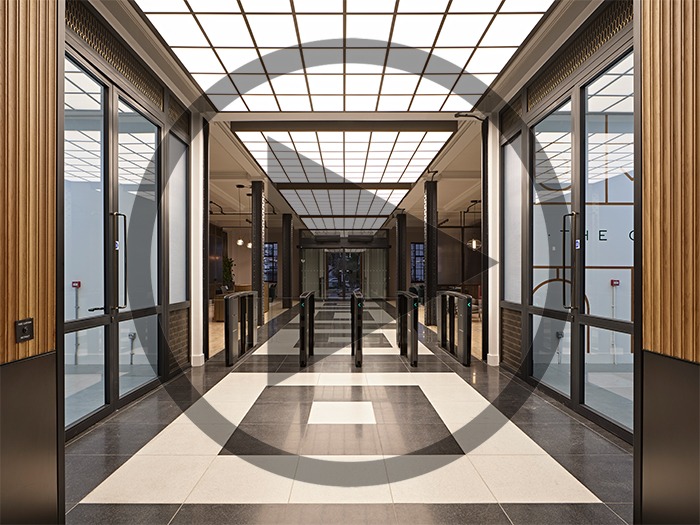
Unibox partnered with architectural firm, Stiff + Trevillion, supplying a series of bespoke LED ceiling lightboxes for the redevelopment of one of London’s premier Art Deco buildings – The Gilbert & One Lackington. Future-orientated materials and lighting technologies blend seamlessly with the original building’s 1930s heritage to create 200,000sqft of premium commercial lets that are equipped to meet the demands of modern businesses whilst upholding the values of today’s world.
IALD host worldwide Chase the Dark Event
(Worldwide) – On 24 March, the International Association of Lighting Designers (IALD), held its annual Chase the Dark event, inviting designers around the world to get together both in person and virtually to celebrate the power of light.
The annual event begins in Australia, and makes its way across each time zone moving west, to create a 24-hour celebration, in which the 35 regions and chapters of the association can come together.
This year, the theme of “Only Light Where You Need It” encouraged participants to use light wisely, with as little impact to the environment as possible – as such, participants played with the characteristics of UV light to create artistic paintings and sculptures using a range of reactive materials.
As with previous years, social media played a large part in the event, with participants sharing their work on Instagram, using the hashtag #ialdchasedark.
Speaking of the event, the IALD said: “Light pollution, energy waste and sustainable manufacturing are problems that need to be addressed within the lighting community. The role of the lighting designer is crucial to educate and design solutions to minimise disruption and deliver sustainable solutions. The IALD is working together with policy makers, manufacturers and education establishments on best practices for environmental sustainability.”
Search #ialdchasedark on Instagram to see this year’s Chase the Dark efforts.
ROLAN 2022 online conference announced for 12-13 May
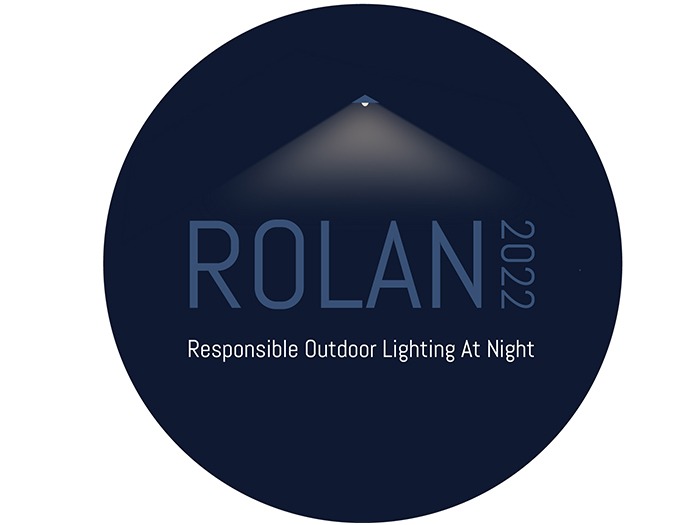
Bringing together the industry’s foremost researchers and practitioners, the Society of Light and Lighting (SLL) and Assistant Professor Dr. Karolina M. Zielinska‐Dabkowska, ILLUME/Gdańsk University of Technology, Poland are launching the inaugural international Responsible Outdoor Lighting at Night (ROLAN) conference. Taking place online on 12 – 13 May 2022, ROLAN 2022 is a two‐day online conference designed to facilitate much‐needed collaboration and the support necessary to improve lighting practice and to enhance research, as well as providing networking opportunities between practitioners, researchers and manufacturers.
The conference will utilise the immense depth of knowledge, expertise, and innovation of an international panel of speakers, presenting unique perspectives from lighting and related disciplines and research areas. Aiming to broaden horizons, increase understanding, and improve communication between researchers, lighting professionals for the benefit of the environment and society as a whole.
Organisers are hopeful that the event will offer an outstanding occasion for lighting professionals, architects, town planners, landscape designers, lighting manufacturers, local authorities, ecologists, and researchers to keep up‐to‐date with recent findings. Much has changed since the introduction of LED lighting, and it is necessary to reduce its impact on all aspects of the environment.
The programme includes 31 renowned speakers from across Australia, Europe and the United States, covering a range of expertise specialisms such as lighting design, environmental science, biology, astronomy, medical science and legal aspects. The talks have been divided into four dedicated sessions: Losing our dark nights; Best lighting practice(s) to reduce light pollution; Light pollution legal aspects; and the impact of light exposure at night on the environment and humans.
In developing the programme, the organisers contacted leading figures from the industry to gauge their response to the proposed topic.
Mark Major, Senior Partner, Speirs Major, said: “We need artificial light as a society, but how do we balance its use with the environmental impact that it creates? How do we reduce energy use, light pollution, ecological damage and electronic waste, whilst continuing to create great experiences for people after dark? These are just some of challenges that confront us, not only in the future but right now. I really look forward to participating in the debate about new ways of working with outdoor lighting at night.”
Florence Lam, Global Lighting Design Director, Arup, said: "We need to shift our lighting design paradigm towards a humanity‐centric approach. This entails designing with the long‐term health and wellbeing of people, place and planet in mind, harmonising the symbiotic relationship between humans and biodiversity."
Allan Howard, Group Technical Director Lighting and Energy Solutions, WSP, said: "I am delighted to have been invited to speak at the Responsible Outdoor Lighting at Night inaugural conference regarding obtrusive light. The application of all forms of artificial light at night is an important global topic, not just with respect to dark skies but within all environments through to city centres. The more we can raise the importance of good lighting design undertaken by competent designers to protect the environment, the better."
The ROLAN 2022 organisers would like to thank the conference Founding Partners: International Dark‐Sky Association (IDA), International Association of Lighting Designers (IALD), Illuminating Engineering Society (IES), ILLUME, Institute of Lighting Professionals (ILP), and Society of Light and Lighting, who begin this important paradigm shift together. Members of Founding Partners can access the conference at SLL member rate.
For more details including: speakers, programme and registration, visit: www.cibse.org/ROLAN22

Lutron unveils Prismatic in UK roadshow
(UK) – Lutron Electronics has introduced its new Lutron By Design Experience – Prismatic – to the lighting design community with two interactive events across the UK.
First hosted at Manchester Cathedral, and then at the Tate Modern in London’s Bankside district, the events allowed the UK’s architecture and design community to experiment with light in a bespoke, iridescent cube fit out with Lutron lighting and controls. The interplay of light and iridescent colour delivered an immersive experience for the designers.
During the events, guests were able to get hands-on time with the Lutron Lighting Designer App, to play with the system and save their lighting creations for the pop-up structure.
Prismatic is made possible by the Athena solution – Lutron’s simple and flexible lighting and shading control solution that puts the power to personalise light in the hands of designers and end users. Athena marries best-in-class control, unparalleled flexibility, and simple app-based setup in a lighting and blinds control solution that is ideally suited to handle the evolving needs of commercial spaces throughout the world.
“Lutron launched in the 1960s with the aim of creating technology that would enable individuals to control light, inventing the dimmer switch,” said Nicolla Farry, Specification Sales Supervisor at Lutron Electronics. “For 60 years we have been striving to provide the perfect light to our users. Prismatic provides lighting designers and the design community at large with the ability to manipulate light and experience first-hand the potential of Athena.”
Following the Manchester and London events, Prismatic will continue in Madrid, Paris, and Milan starting in April 2022.
Workshop Heads revealed for Lights in Alingsås 2022
(Sweden) – Organisers of Lights in Alingsås have announced the Workshop Heads for the 2022 event.
Returning for its 23rd year, workshop heads for this year’s light festival include: Mieke Goessling; Jonathan Plumpton; Kay Flounders; Martina Alagna; Berry van Egten and Ellen Goulmy; and Michaela Bonzi and Frank Seemann.
For the first time since before the pandemic, the annual light festival was able to invite the workshop heads to a concept meeting in the Swedish town of Alingsås this month. During the weekend-long session the theme for this year’s event was introduced, and the designers were able to walk the lighting trail for the first time, before choosing the locations that they wish to illuminate this autumn – the theme and route will be officially revealed later in the spring.
Having already been a workshop head in 2008, Berry van Egten said: “Lights in Alingsås is a beautiful place, which Ellen and I visit every year. We love the town and the concept of the event – we love to teach and inspire the participants with our love for lighting.”
Kay Flounders added: “The opportunity to be involved with Lights in Alingsås is so special. To bring lighting designers and students from around the world together to produce an event that allows people to be immersed in light is something truly wonderful.”
Find out more about the workshop heads here.



